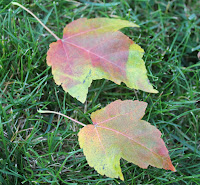 |
| Carteniods, tannins, anthocyanins, color these maple, oak and blue berry leaves. |
“Yes they are, Berzo. They put on their prettiest dress of the year, then the wind blows it away. Woosh!”
She cracks up at her joke and points out another naked tree.
Why do the colors change? Why do the trees get naked when everything else in nature is bundling up in layers of fur and fat? Why only broadleaf trees? What are leaves good for?
If you too have a curious six-year-old rapid firing these questions, and if you—like me—can't remember your fifth grade science, here are some interesting facts I've collected about autumn leaves.
Why do the colors change?
Cued by the longer hours of darkness and falling temperatures, the veins feeding the leaves withdraw nutrients (nitrogen and phosphorus) and begin to clog the veins where the leaf meets the twig. Chlorophyll production decreases, then stops, causing the leaf to lose its green color. Once the green color has faded, the other colors, already present in the leaf, get their turn in the sunlight. For some oak trees, the tannins in the leaves leave them brown, (the same tannins that flavor wines and spirits store in oak barrels) in maples, it's the carotenoids turn to shine their yellow hues.
The exception is the brilliant reds and purples put on by white oaks, sugar maples and a few other varieties. Those colors are not present in the leaf until after the veins are clogged. The abandoned chlorophyll continues to produce sugar which reacts with anthocyanidins, producing anthocyanins pigments; which happen to be brilliant pinks, reds and purples. This is why leaves that get the most sun are often the most brilliant, whereas the more shaded leaves stay pale green longer. Some leaves even create a sun tan line on another leaf with its shadow.

|
There are many environmental factors that influence the brilliance of fall leaves, including spring and summer rainfall, and fall temperatures and frost. A page on Butler.Edu states: "A warm, wet spring, normal summer rainfall, and warm sunny fall days with cool nights produce the most brilliant summer colors."
Why do the trees get naked?
As mentioned above, longer nights are cooler temperatures are the most influential factors causing the tree to start the abscission layer on each leaf petiole. (Petiole: base of the leaf stem where it is attached to the twig). Reacting to both factors are essential for the survival of the tree. The leaves are tender and susceptible to freezing, which would endanger the health of the tree. Also by the end of the year the leaves sustain a fair amount of damage from insects, disease, wind, etc. Once naked, the rest of the tree, heavily armored with bark, is ready for the winter.
Why only broadleaf trees?
Needle and scale leafed trees, i.e. softwoods, have rolled and sealed their leaves up in wax, and their sap acts like antifreeze. By retaining their leaves all year, (except the tamarack which sheds it's needles) they are able to grow even in the short days of winter, which allows them to eventually outpace their broadleaf counterparts.
You can tell when a forested area has recently been disturbed by fire or logging, if there is an abundance of broadleaf trees, (which germinate readily and grow fast, initially) with smaller softwoods like douglas fir and cedars. In another fifty years or so the broadleaf hardwoods will be crowded out by the lofty needled softwoods.
What are leaves good for?
An adult would ask, “What role do fallen leaves play in forest ecology?” But, Boots phrases all ecology questions in this way, "What are ants good for?", "What are slugs good for?"
Fallen leaves enrich the soil as they decompose, essentially providing a fresh layer of compost, small mammals use them in nest construction, like our resident squirrel who has constructed an impressive nest out of leaves, and many insects species eat them. Worms play a big part in composting leaves by dragging them into their burrows, eating them and casting off nutrient rich fertilizer. Leaves also capture water that might otherwise runoff. Fallen leaves play a significant role in maintaining that spongy layer of loam on the forest floor.
For Further Reading:
Leaf Color Change:
Wine Tannins
Hardwoods Vs. Softwoods


No comments:
Post a Comment